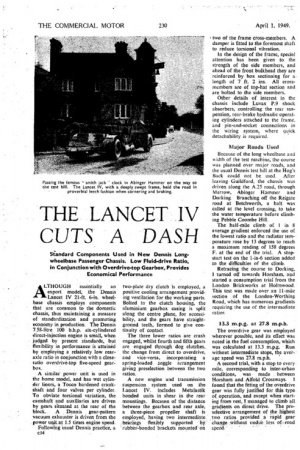THE LANCETI IV CUTS A DASH
Page 20

If you've noticed an error in this article please click here to report it so we can fix it.
Siandard Components Used in New Dennis Long.. wheelbase Passenger Chassis. Low Fluid-drive Ratio, in Conjunction with Overdrive-top Gearbox, Provides Economical Performance
ALTHOUGH essentially an export model the Dennis Lancet IV 21-ft. 6-in, wheel. base chassis employs components that are common to the domestic chassis, thus maintaining a measure of standardization and promoting economy in production. The Dennis 7.58-litre 100 . b.h.p. six-cylindered direct-injection engine is small, when judged by present standards, but flexibility in performance is attained by employing a relatively low rearaxle ratio in conjunction with a closeratio overdrive-top five-speed gear
box. .
A similar power unit is used in the home model, and has wet cylinder liners, a Tocco hardened crankshaft and four valves per cylinder. To obviate torsional variation, the camshaft and auxiliaries are driven by gears situated at the rear of the block. A . Dennis gear-pattern vacuum _exhauster is driven from the. . power unit. at 1.5 times engine speed. Following usual Dennis practice, a c14 two-plate dry clutch is employed, a, positive cooling arrangement providing ventilation for the working parts. Bolted to the clutch housing, the aluminium gearbox casing is split along the centre plane, for accessibility, and the gears have straightground teeth, formed to give continuity of contact.
The three lower ratios are crash engaged, whilst fourth and fifth gears are engaged through dog clutches, the change from direct to overdrive, and vice-versa, incorporating a spring-loaded .toggle arrangement giving preselection between the two ratios.
A new engine and transmission suspension system used on the Lancet IV. includes Metalastik bonded units in shear in the rear mountings. Because of the distance between the gearbox and rear axle, a three-piece propeller shaft is employed, having two intermediate bearings flexibly supported by rubber-bonded brackets mounted on two of the frame cross-members. A damper is fitted to the foremost shaft to reduce torsional vibration.
in the design of the frame, special attention has been given to the strength of the side members, and ahead of the front bulkhead they are reinforced by box sectioning for a length of 7 ft. 2 ins. All crossmembers are of top-hat section and are bolted to the side members.
Other details of interest in the chassis include Luvax P.9 shock absorbers, controlling the rear suspension, rear-brake hydraulic operating cylinders attached to the frame, and pin-and-socket connections in the wiring system, where quick detachability is required.
Major Roads Used Because of the long wheelbase and width of the test machine, the course was planned over major roads, and the usual Dennis test hill at the Hog's Back could not be used. After leaving Guildford, the chassis was driven along the A.25 road, through Merrow, Abinger Hammer and Dorking Branching off the Reigate road at Betchworth, a halt was called at the level crossing, to take the water temperature before climbing Pebble Coombe Hill.
The half-mile climb of 1 in 8 average gradient enforced the use of the lowest ratio and the radiator temperature rose by 13 degrees to reach a maximum reading of 158 degrees F. at the end of the trial. A slopstart test on the 1-in-6 section added to the difficulties of the climb.
Retracing the course to Dorking, 1 turned off towards Horsham, and started a consumption trial from the London Brickworks at Holmwood. This test was made over an 11-mile section of the London-Worthing Road, which has numerous gradients requiring the use of the intermediate ratios
13.3 m.p.g. at 27.8 m.p.h.
The overdrive gear was employed wherever possible, and its effect was noted in the fuel consumption, which was calculated at 13.3 m.p.g. Run without intermediate stops, the average speed was 27.8 m.p.h.
A second trial, with a stop to every mile, corresponding to inter-urban conditions, was made between Horsham and Affold Crossways. I found that the fitting of the overdrive gear was fully justified for this type of operation, and except when starting from rest, I managed to climb all gradients on direct drive. The preselective arrangement of the highest two ratios provided a rapid gear change without undue loss of. road
speed. "


























